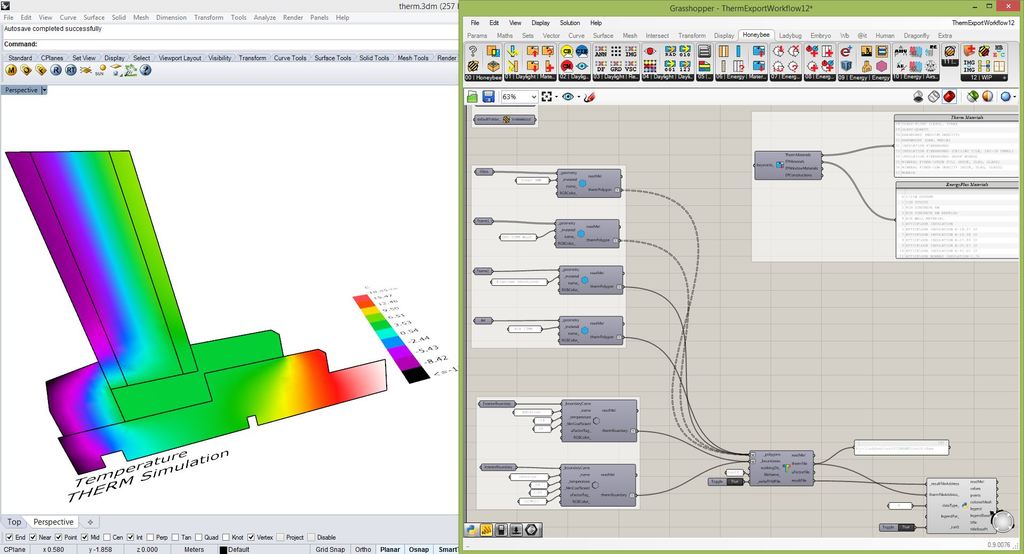
IBPSA-USA Research Committee: Automated 2D Heat Transfer with Grasshopper (1 LU)
The predominant tool for 2D heat transfer analysis is THERM which has a toilsome interface for drafting and post-processing façade details. The proposed interoperable algorithmic modeling (IAM) workflow utilizes the friendly drafting environment in Rhino as inputs to a Grasshopper (GH) file that utilizes open source Ladybug Tools to set up, simulate and post-process unique customizable heat transfer results. The GH file is interoperable with THERM and InDesign to generate and automate the generation of a consistent thermal analysis report. This workflow cuts down on production time, generates consistent outputs, and advocates interoperability in a user-friendly environment.
The IAM Workflow was used effectively for a hospital located in Minneapolis, MN. Many contributors were all brought to the table to evaluate the performance of an existing curtainwall. The extreme climate in conjunction with humidified zones is the perfect breeding ground for condensation. This fourteen year old hospital presented moisture reports within the first few years of occupancy. The specification of condensation resistance factor (CRF) was incorrect and also not a guarantee of no condensation as the present day two dimensional finite element thermal analysis reinforced. The hospital is replacing the punched window and curtainwall assemblies with the priority of eliminating condensation reports; this process involved the architect, owner, operator, contractor and simulation analyst collaboration to develop informed simulations to provide confidence that the new assemblies would eliminate the perpetual winter condensation issue.
Real time evaluation of framing options, material selection, and design detailing on weekly calls with the entire team created an environment of understanding and trust across the team. A valuable exchange of information occurred to better inform the two-dimensional heat transfer modeling of the fenestration details to ensure the design solution would deliver on reduced condensation reports and informed operational strategies on the design day conditions. Six weeks of collaboration and analysis with the team decided on a solution everyone stood behind. Façade replacement began during the winter when Minneapolis did experience actual design day conditions. This presented the modeler with the task of verifying that the ‘field measurements the client took at the existing condition and in-progress replacement assemblies matched the predicted temperature from the model. The delta between the actual and simulated surface temperatures was deemed acceptable as the restraints of the simulation software were explained. The accuracy of the surface temperatures gave further credibility to the simulation process as a predictive indicator of condensation risk probability and mitigation.
Date
- Jun 25 2020
- Expired!
Time
- 12:00 pm - 1:00 pm
Local Time
- Timezone: America/New_York
- Date: Jun 25 2020
- Time: 3:00 pm - 4:00 pm
Next Event
- AIASF Design Awards Gala
-
Date
- Apr 18 2024
-
Time
- 5:00 pm
Recent Posts
- Women in Architecture Held it’s First Annual Recognition Party!
- Take a Look at Our 1st Annual AIAS Design Competition
- Tim Nystrom: A Visionary Leader in Architecture | Member Spotlight
- We Had a Radical Time with Marlon Blackwell’s Joint Lecture Series Talk!
- Valuation Threshold – Chapter 11B-202 and Alterations affecting Accessibility by Kerwin Lee, AIA
Recent Comments
- Our 2023 Member Appreciation Party was A Night to Remember! - AIA – East Bay Chapter on Congratulations to our 2024-2026 Board Members!
- 2023 Design Awards Winners Announced! - AIA – East Bay Chapter on 2023 Design Award Nominees Announced!
- Robert Cooley on Plumbing Fixtures in the 2022 Codes by Kerwin Lee, AIA
- AIA East Bay on AIAEB Launches New Membership Outreach Program
- madeleine@mzmdesignworks.com Zayas on Last Night’s Member Appreciation Party
Archives
- March 2024
- February 2024
- January 2024
- December 2023
- November 2023
- October 2023
- September 2023
- August 2023
- July 2023
- June 2023
- May 2023
- April 2023
- March 2023
- February 2023
- January 2023
- December 2022
- November 2022
- October 2022
- September 2022
- August 2022
- July 2022
- June 2022
- May 2022
- April 2022
- March 2022
- February 2022
- January 2022
- December 2021
- October 2021
- September 2021
- August 2021
- July 2021
- June 2021
- May 2021
- April 2021
- March 2021
- February 2021
- January 2021
- December 2020
- November 2020
- October 2020
- September 2020
- August 2020
- July 2020
- June 2020
- May 2020
- April 2020
- March 2020
- February 2020
- January 2020
- December 2019
- October 2019
- September 2019
- August 2019
- July 2019
- June 2019
- May 2019
- April 2019
- March 2019
- February 2019
- December 2018
- November 2018
- October 2018
- September 2018
- August 2018
- July 2018
- June 2018
- May 2018
- April 2018
- March 2018
- February 2018
- January 2018
Categories
- ADA/Accessibility
- Archinect
- ArchNews
- Awards
- CES
- Classified/Announcement
- Committees & Forums
- Design
- Emerging Professionals
- Large
- Lecture
- Licensure
- Medium
- Member Spotlight
- Monthly Program
- Networking/Social
- News
- Partners
- Professional Practice
- Programs & Events
- Small
- Small Firm Forum
- Student
- Tours
- Unbuilt
- Uncategorized
- User Groups
Responses